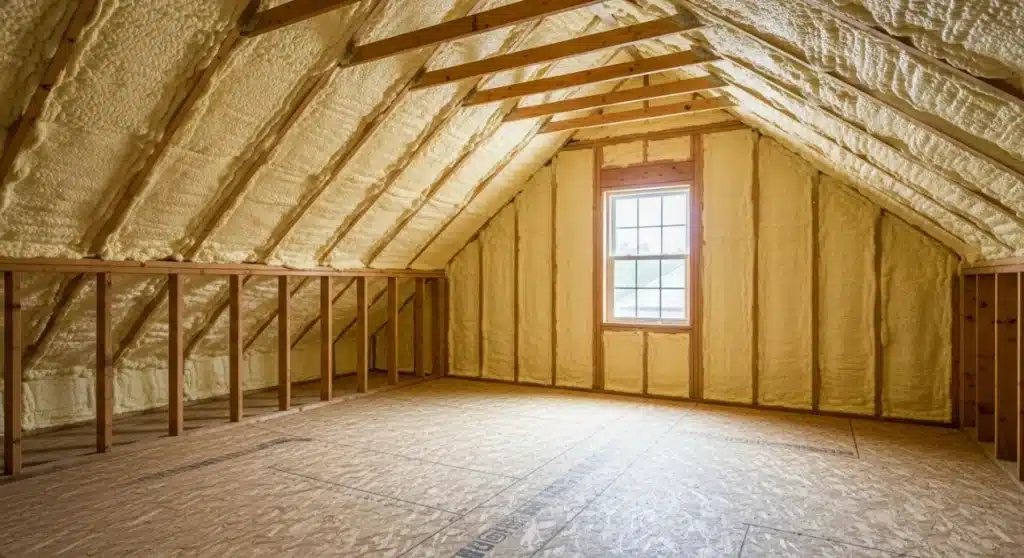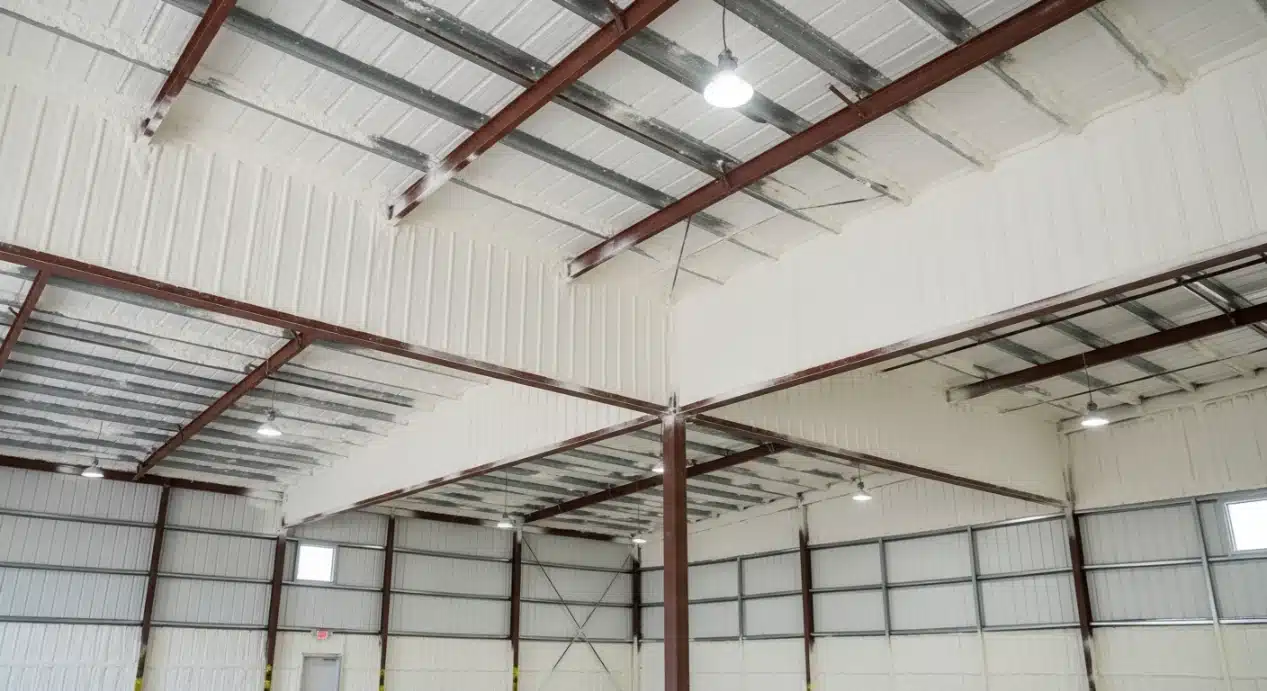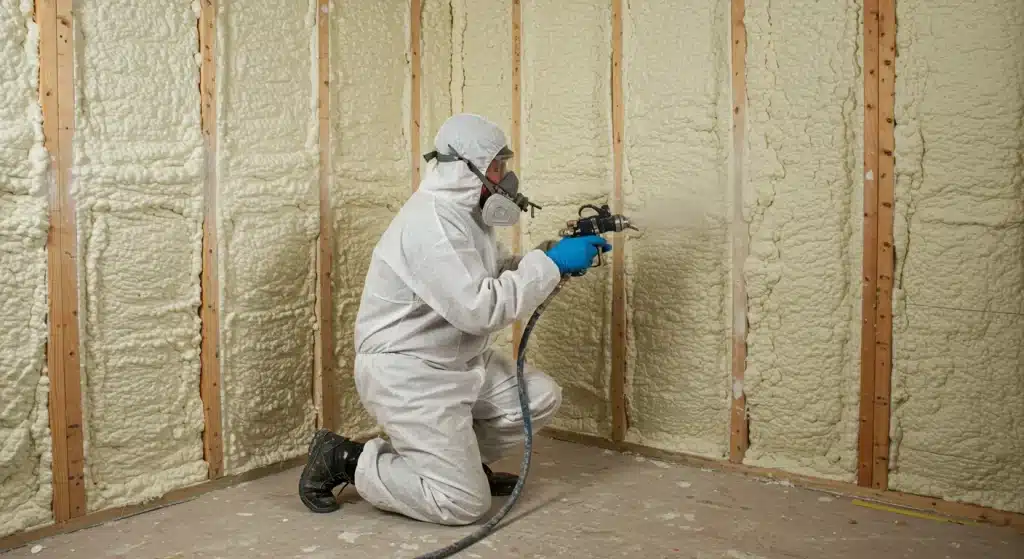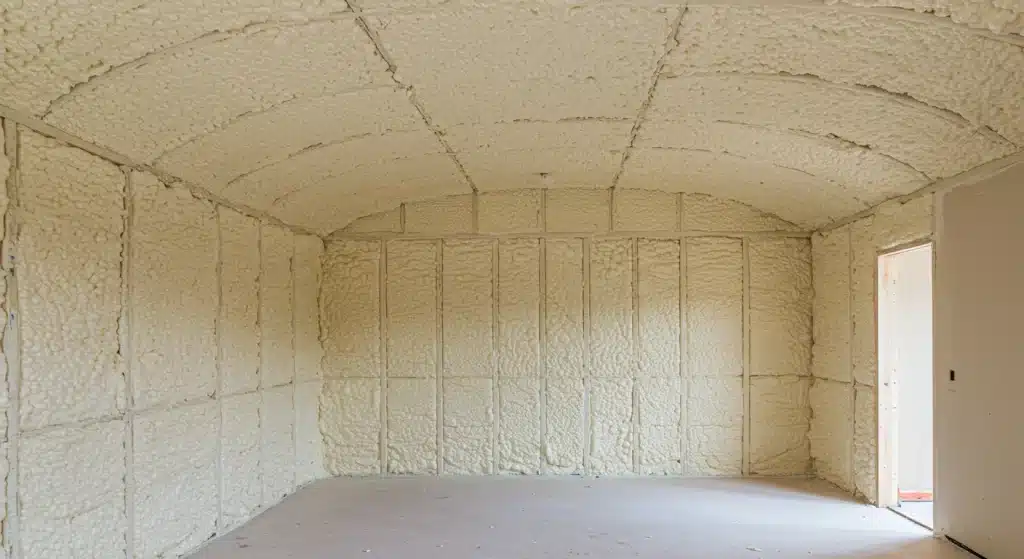Feeling the chill of a draft in the winter or the oppressive heat of summer inside your own home is more than just an inconvenience. It’s a constant reminder that your home’s thermal barrier isn’t performing as it should. High energy bills, inconsistent temperatures from room to room, and concerns about allergens or moisture are common problems that traditional insulation materials often fail to solve completely. You’ve likely invested in your property, and you deserve to be comfortable in it without paying a fortune in heating and cooling costs. This is where modern insulation technology, specifically spray polyurethane foam (SPF), changes the game.
Spray foam isn’t just another type of insulation; it’s a comprehensive air sealing and insulating material rolled into one. Unlike batts or blown-in insulation that can leave gaps and settle over time, spray foam creates a continuous, monolithic barrier that conforms to every nook and cranny. This guide is built on years of hands-on experience, designed to walk you through everything you need to know. We’ll cover the fundamentals, compare the different types of foam, explore its many benefits, and break down the installation process and long-term value.
By the time you finish this guide, you will understand:
- The fundamentals of what spray foam insulation is and how it works.
- The critical differences between open-cell and closed-cell foam.
- How spray foam can dramatically improve your home’s energy efficiency and comfort.
- The various applications for spray foam, from attics to crawl spaces.
- What you should expect during a professional installation.
- How to evaluate the cost and impressive return on investment.
What Exactly Is Spray Foam Insulation?
At its most basic, spray foam insulation is a chemical product created by mixing two separate liquid components, an isocyanate and a polyol resin. When these two liquids are combined at the tip of a spray gun, they react, expand, and harden into a solid foam. This expansion is what makes it so effective. The foam expands up to 100 times its initial volume in just a few seconds, allowing it to fill every gap, crack, and crevice in the building envelope.
This process creates a custom-fit insulation barrier that is far superior to pre-cut materials like fiberglass batts. It doesn’t just slow down heat transfer through conduction (the R-value); it also stops air leakage (convection). The U.S. Department of Energy states that air leakage can account for up to 40% of the energy used to heat and cool a typical home. By creating an effective air seal, spray foam addresses this massive source of energy waste head-on, something most other insulation types can’t do on their own.
The Two Main Types: Open-Cell vs. Closed-Cell
Not all spray foam is created equal. The two primary types, open-cell and closed-cell, have different characteristics and are suited for different applications. Understanding their distinctions is key to making the right choice for your project.
Open-Cell Spray Foam
Open-cell spray foam is soft, flexible, and has a spongy texture. Its cells are not fully encapsulated, which allows air to fill the “open” space inside the material. This structure makes it an excellent sound-dampening material. It is also vapor-permeable, meaning it allows moisture to pass through it, which can be beneficial in certain climates and applications as it lets the building assembly breathe and dry out if it gets wet.
Closed-Cell Spray Foam
Closed-cell spray foam is rigid, dense, and strong. Its cells are completely closed and packed tightly together, filled with a gas that helps the foam rise and expand. This dense structure gives it a higher R-value per inch than any other common insulation material. A report from the U.S. Department of Energy notes that closed-cell foam has an R-value of around R-6.0 to R-7.0 per inch. It is also a certified vapor barrier, meaning it blocks the movement of moisture, and its rigidity can even add structural strength to walls and roofs.
Here’s a direct comparison to help you see the differences:
| Feature | Open-Cell Spray Foam | Closed-Cell Spray Foam |
|---|---|---|
| R-Value per Inch | ~R-3.5 to R-3.8 | ~R-6.0 to R-7.0 |
| Density | Low (0.5 lbs/cubic foot) | High (2.0 lbs/cubic foot) |
| Moisture Permeability | Vapor Permeable (lets vapor pass) | Vapor Barrier (blocks vapor) |
| Air Barrier | Excellent | Excellent |
| Sound Dampening | Excellent | Good |
| Structural Strength | No | Yes, adds racking strength |
| Cost | Lower | Higher |
| Common Uses | Interior walls, attic roof decks, soundproofing | Exterior walls, crawl spaces, roofs, areas needing a vapor barrier |
Key Takeaways
- Choose Closed-Cell Foam when you need the highest possible R-value in a limited space, require a vapor barrier, or want to add structural integrity. It’s the go-to choice for basements, crawl spaces, and rim joists.
- Choose Open-Cell Foam for interior applications where sound dampening is a priority and a vapor barrier isn’t necessary. It’s often used in walls between rooms and on the underside of roof decks in conditioned attics.
The Unmatched Benefits of Spray Foam
The reason spray foam has become so popular in both new construction and retrofits is its long list of tangible benefits that go far beyond just keeping a home warm or cool.
Superior Thermal Performance
The primary job of insulation is to resist heat flow, which is measured in R-value. Closed-cell spray foam offers one of the highest R-values available, making it incredibly effective at insulating your home. This means you get more insulating power with less thickness compared to other materials.
An Unbeatable Air Seal
As mentioned, spray foam’s ability to expand and create a continuous air barrier is its biggest advantage. It seals the gaps around outlets, plumbing penetrations, and framing that are notorious for air leaks. This comprehensive seal stops drafts, reduces energy loss, and creates a much more comfortable indoor environment.
Moisture and Mold Resistance
Closed-cell spray foam is non-porous and acts as a vapor barrier, which helps prevent moisture from entering your wall cavities or attic. Because it contains no organic material (like the paper backing on fiberglass), it does not support mold growth. By controlling moisture, you protect your home’s structural integrity and improve indoor air quality.
Expert Tip: In damp areas like basements or crawl spaces, closed-cell spray foam is the best choice. It insulates and seals out ground moisture in one step, preventing the musty smells and mold problems common in below-grade spaces.
Added Structural Strength
The dense, rigid nature of closed-cell spray foam allows it to adhere to surfaces and add significant racking strength to the building structure. When applied to wall sheathing or roof decks, it essentially glues the structure together, making it more resistant to wind and other pressures.
Longevity and Durability
Unlike fiberglass or cellulose, spray foam is a rigid, inert polymer. It won’t sag, settle, or break down over time. Once installed, it performs for the life of the building without needing to be topped up or replaced, providing consistent performance for decades. This exceptional durability is a key reason the global spray foam insulation market is projected to continue its strong growth; analysis from Grand View Research attributes this trend to its durability and energy-saving properties.
Effective Sound Dampening
Open-cell spray foam, in particular, is fantastic at absorbing sound waves. Its soft, irregular cell structure breaks up and reduces the transmission of airborne noise. This makes it a great option for media rooms, home offices, or walls between bedrooms and bathrooms to create a quieter, more peaceful home. Given these significant advantages, it’s no surprise that spray foam is a versatile solution applicable to many parts of a home.

Common Applications: Where Can You Use Spray Foam?
Spray foam’s versatility allows it to be used in nearly any part of the building envelope. Here are some of the most common and effective applications.
Attics and Roof Decks
Insulating an attic is one of the most effective ways to improve a home’s energy efficiency. Applying spray foam directly to the underside of the roof deck creates a conditioned or semi-conditioned attic space. This approach, known as an “unvented attic,” keeps the attic much cooler in the summer and warmer in the winter, which is ideal for homes with HVAC equipment located in the attic.
Walls and Rim Joists
In new construction, spraying foam into wall cavities before drywall provides a complete air seal and high R-value. In existing homes, it can sometimes be injected into walls. The rim joist, the wooden perimeter that sits on top of your foundation, is a major source of air leakage. Sealing and insulating it with closed-cell spray foam is a quick and highly effective upgrade.
Crawl Spaces and Basements
Crawl spaces and basements are often damp, musty, and a huge source of energy loss. Applying closed-cell spray foam to the foundation walls isolates the crawl space from the ground and outdoor air, making it cleaner, drier, and warmer. This greatly improves the comfort of the floors above and overall home air quality.
The Installation Process: A Step-by-Step Look
A professional spray foam installation is a precise process that requires specialized equipment and training. It’s not a typical DIY project due to the safety and technical requirements. Here’s what you can expect.
- Preparation: The crew will first prepare the area by removing any old, ineffective insulation. They will then cover and mask off any surfaces that shouldn’t be sprayed, such as windows, floors, and mechanical equipment.
- Safety First: Installers wear full-body protective suits, respirators, and gloves. The home needs to be properly ventilated during application and curing, and homeowners, along with their pets, are typically required to leave the premises for up to 24 hours.
- Application: The foam is sprayed as a liquid, which quickly expands to its final thickness. The installers apply it in layers or “lifts” to ensure proper curing and achieve the desired R-value.
- Curing and Trimming: The foam hardens and cures within minutes. In applications like wall cavities, any excess foam that expands beyond the studs is trimmed flush to allow for the installation of drywall.
- Cleanup: Once the job is complete, the crew removes all masking materials and leaves the site clean.
Expert Tip: Always ask your installation company about their safety protocols. A reputable contractor will insist on vacating the home during the application and curing period to ensure there is no exposure to chemical vapors before they fully dissipate.
Understanding the Cost and Value Proposition
It’s true that spray foam insulation has a higher upfront cost than traditional materials like fiberglass or cellulose. However, viewing it only as an expense is short-sighted. It’s an investment in your home’s long-term performance and efficiency.
The price of a project depends on several factors:
- Type of foam: Closed-cell is more expensive than open-cell.
- Thickness: The higher the desired R-value, the more material is needed.
- Project size: The total square footage to be insulated is a primary factor.
- Accessibility: Difficult-to-reach areas may increase labor costs.
The real story is the return on investment (ROI). Because spray foam can drastically reduce air leakage and improve thermal performance, the energy savings are substantial. Many homeowners see a reduction of 30% or more on their heating and cooling bills. A study highlighted by the Spray Polyurethane Foam Alliance found that homes with SPF insulation can achieve significant energy cost savings. Over several years, these savings can pay back the initial investment, after which the savings continue for the life of the home.
Putting Your Insulation Strategy into Action
Choosing the right insulation is one of the most important decisions you can make for your home’s comfort, efficiency, and longevity. Spray foam offers a comprehensive solution that not only provides superior thermal resistance but also creates an air and moisture barrier, adding strength and durability to your property.
By understanding the differences between open-cell and closed-cell foam and identifying the key areas of your home that would benefit most, you can make an informed decision. While the initial cost is higher than some alternatives, the long-term energy savings, improved comfort, and lasting performance deliver an outstanding value that pays dividends for decades. Use this guide as your reference as you explore how to create a more efficient and comfortable living space.
Need Expert Guidance?
Navigating the world of insulation can be complex, but you don’t have to do it alone. If you have questions about your specific project or want a professional assessment of your home’s insulation needs, the team at Supreme Spray Foam LV is here to help. For a no-obligation consultation, you can reach us at (702) 904-9895 or send an email to [email protected].
Sources
- U.S. Department of Energy– Provides consumer-facing information on spray foam insulation, including types and R-values.
- Grand View Research – Offers market analysis and forecasts for the global spray foam insulation industry.
- Spray Polyurethane Foam Alliance – An industry organization providing technical documents and research on the benefits of SPF insulation.
Frequently Asked Questions About Spray Foam Insulation
How long does spray foam insulation last?
When installed correctly, spray foam insulation does not shrink, sag, or settle. It is a stable material that should last for the entire lifespan of your home without needing replacement.
Is spray foam insulation flammable?
Spray foam is required by building codes to have fire retardants added to its formula. While it is a plastic material and will burn if exposed to a sufficient flame, it must be separated from the interior of the home by a 15-minute thermal barrier, which is typically half-inch drywall.
Can I install spray foam myself?
While DIY kits are available, they are generally only suitable for very small projects like sealing gaps. A full home insulation project requires expensive, high-pressure equipment and extensive safety training. For the best results and safety, it is strongly recommended to hire a professional contractor.
Does spray foam smell?
There is a distinct odor during the application and curing process, which is why the home must be vacated. Once the foam is fully cured (usually within 24 hours), it becomes inert and odorless. Any lingering smell could indicate an improper mix or application.
How thick should spray foam be applied?
The required thickness depends on the type of foam and your local building code requirements for R-value. For example, to achieve R-20, you would need about 3 inches of closed-cell foam or about 5.5 inches of open-cell foam.






